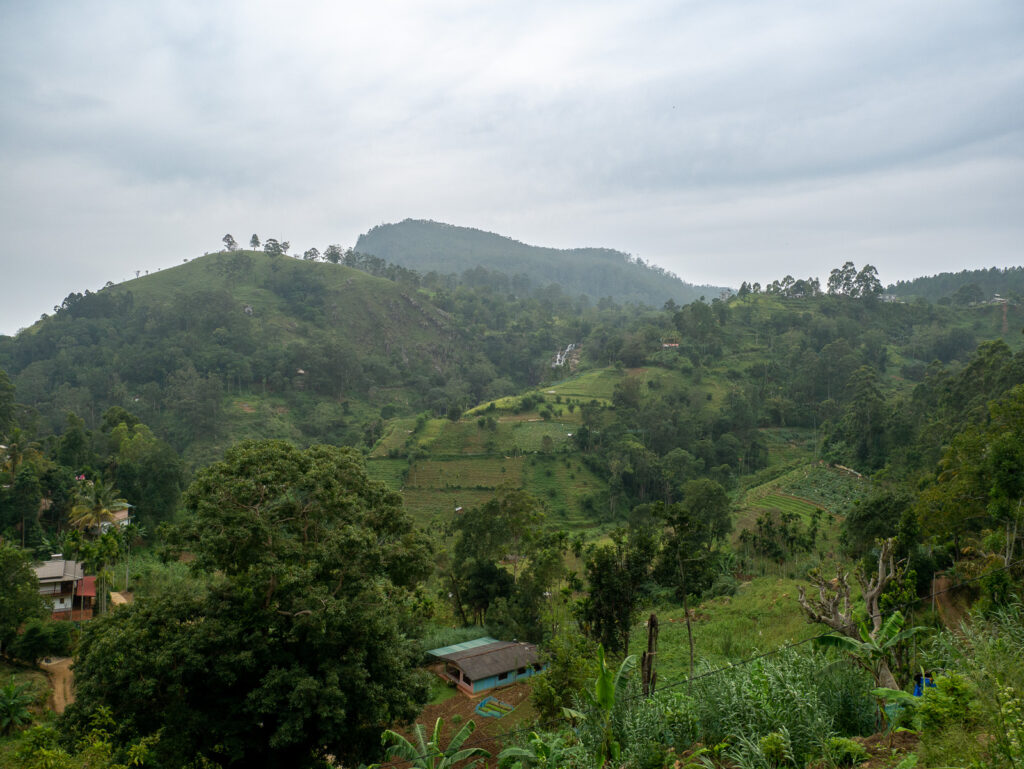
The upper portion of Kuda Ravana Falls in the distance.
Riding the Ella Odyssey: The Most Spectacular Part of the Ride (Part 3 of 5)
(In case you missed it, here is a link to Part 1)
Almost immediately beyond Ella, the vistas swell. No longer were we seeing across a river valley, but across vast highland plains to mountains miles away. One of the first things that strikes you is the upper portion of Kuda Ravana Falls on a distant hillside, behind which is a cave and network of tunnels. Here is where, according to the Sanskrit epic poem, the Ramayana, the “demon king” of Lanka, Ravana, kept Sita, the wife of Prince Rama. The Ramayana tells the life story of the Indian Prince Rama’s exile and eventual return to be crowned king. Ravana, many will tell you, is the chief villain.
Ravana, however, is an interesting character in the stories told about him—while the Ramayana paints him as selfish and evil, Sri Lankans have recast him as a wise king and inventor—cunning, at his worst. According to the poem, Rama had rejected the advances of Shurpanakha, Ravana’s sister, and to make it stick, he and his sidekick, Lakshmana, cut off her nose and ears and sent her packing back to Lanka. (Lanka, by the way, means “island,” but also specifically refers to the island that is Sri Lanka. [And just in case you’re wondering, sri means “resplendent” and is a title of honor. The two combined to become the country’s name in 1972.]) In response to his sister’s disgrace, Ravana took his flying chariot (some Sri Lankans will tell you it was the world’s first airplane) and spirited Rama’s love, Sita, away to Lanka and hid her in a cave behind these falls in an act of revenge.

Ella Station.
Thus, whether Ravana is a lustful interloper like Paris was in The Iliad, or an avenging brother repaying Rama and Lakshmana for their desecration of his sister, is a matter of national bias. It also very much illustrates the relationship between India and Sri Lanka today—perspectives on even recent history will have completely different spins.
Nonetheless, the magnificence of Ravana Falls, top to its bottom some eighty-two feet (of which you can only see a portion from the train), is a sign of the impact of these ancient stories and a land that still bears the weight of thousands of years of history, mythology, and storytelling. The falls feel well named after a “demon king.” While fairly tranquil when we first saw them on the road from Ella to the coast some months earlier, they become monstrous after a heavy rain. Like some of the Hindu gods, many things in Sri Lanka have more than one face.
Ceylon Coffee?
The next few hours were what we’d come for. We passed through spectacular vistas, the intimacy of people’s backyards, lush forests, more waterfalls, the neat plots of high-country vegetable gardens (the only place where “English” vegetables requiring cooler temperatures will grow on the island), chaotic villages teeming with storefronts, marketplaces, and tuk-tuks; and tunnels (there are forty-six between Badulla and Colombo), more bridges over chasms (though no others as spectacular as Nine Arches), tea picker communities with their own kovils (Hindu temples), and the snaking, concentric rows of tea on estates that spanned the hillsides for what looked like miles.
It’s not uncommon to assume that the railway in Sri Lanka was proposed to facilitate the export of highland tea, which is noted today as some of the best in the world and is a backbone of the Sri Lankan economy. However, when the railway was first proposed in 1842, Ceylon was not known for its tea, but for its budding coffee industry. Sometime around 1840, the demand for coffee grew so rapidly in the world that the urgency to cash in on it was proclaimed a “coffee rush.” Traders had experimented with planting coffee as early as the seventeenth century in Sri Lanka, but it didn’t do as well in the lowlands. It needed the highland’s more temperate, less humid climate to thrive, which was not accessible to outsiders until the British took control there.

A tea plantation with trees designed by Dr. Seuss (I’m pretty sure).
By 1840, coffee was already Ceylon’s leading export, transforming the economy and paving the way for the Bank of Ceylon to open in 1841. On an island where anything you plant in the ground seems to thrive, the British cleared tens of thousands of acres of rainforest to create coffee plantations. Since the mountains were sparsely populated after the surrender of the King of Kandy in 1815 (for reasons I won’t go into here, but are fairly disturbing), the British imported Tamil workers from southern India because agriculture was failing there due to poor management (also by the British). By 1863, Ceylon was providing roughly a third of the coffee of Europe, and only Brazil and Indonesia produced more. Ceylon coffee production peaked in 1873 when they exported 111 million pounds.
Unfortunately, though, the endeavor proved ill-fated. A leaf blight (hemileia vastatriz, colloquially known as “coffee leaf rust”) attacked the coffee trees sometime around 1870 and decimated the estates over the next two decades. The British removed the diseased trees and replaced them with tea, which they had first introduced in 1839 and proved resistant to the blight. Tea bushes are hardy and can live a hundred years or more, only needing to be cut back every handful of years to sprout the newer fresh leaves that are better for tea production.
Subsequently, the tea proved more successful than the coffee, and Sri Lanka’s most prominent export became a staple around the world. By the time the British were ready to push the main line of the railway into the high country, Ceylon was all about tea.
From the Mountains Down to the Sea
When we reached our next stop in Idalgashinna, we had hardly caught our breath from running around the train snapping pictures. From Haputale we had been following a ridge line with spectacular distances to see out both sides of the train.
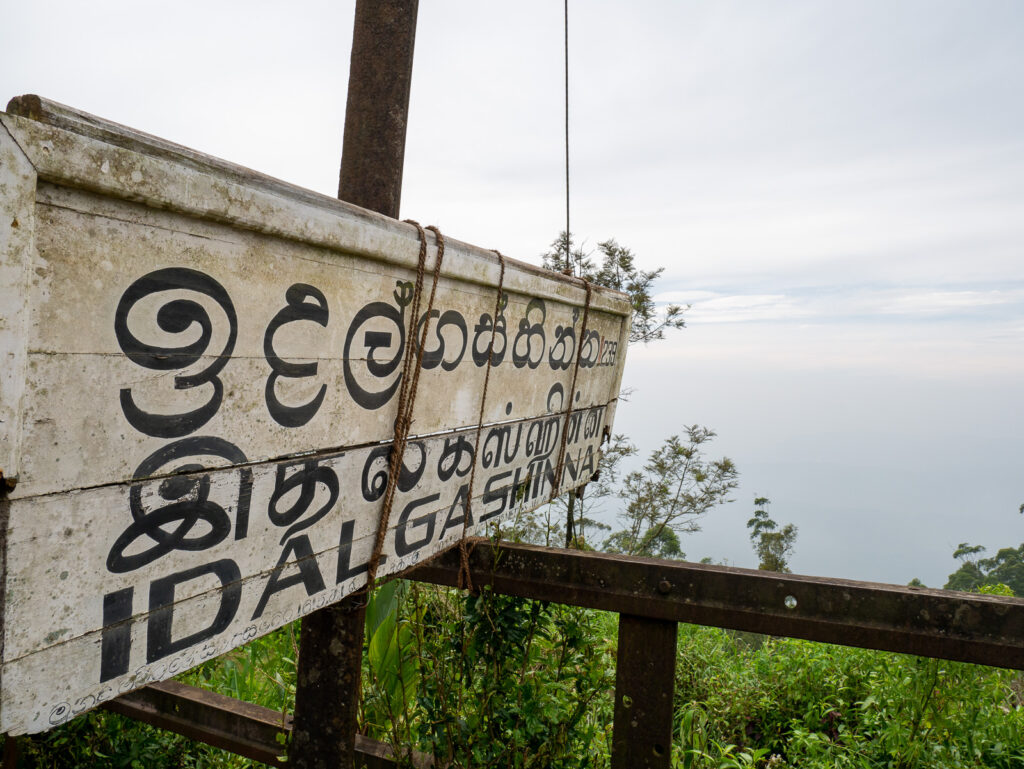
The forest of clouds from Indalgshinna.
Idalgashinna Station seems to sit atop the clouds. To the south, there is a sheer drop toward the Indian Ocean. To the north, the highland valleys of tea plantations open up with Sri Lanka’s tallest mountains in the distance. It’s one of the most spectacular sections of track and a favorite of hikers who want to enjoy the view at a pace even slower than that of the train. It’s also a favorite trek for birders to try to spy a Yellow-eared Bulbul, or a whistling thrush, or any of the other hundreds of rare birds who call Sri Lanka home.
It is said that when it rains on Idalgashinna Station, the southern slope of the roof drains towards the Walawe River and feeds into the great reservoir of Udawalawe National Park, then eventually emptying into the Indian Ocean near Hambantota, while the northern slope empties toward the Mahaweli, which flows north and becomes a mighty river by the time it reaches Kandy. Depending on the winds, it will either be instantly clear or fogged in as the humid lowland air hits the cooler highland breezes. We were told you could see as far as Hambantota on the southern coastline if the conditions are right, but for us, it was a cloud bed as far as the eye could see.
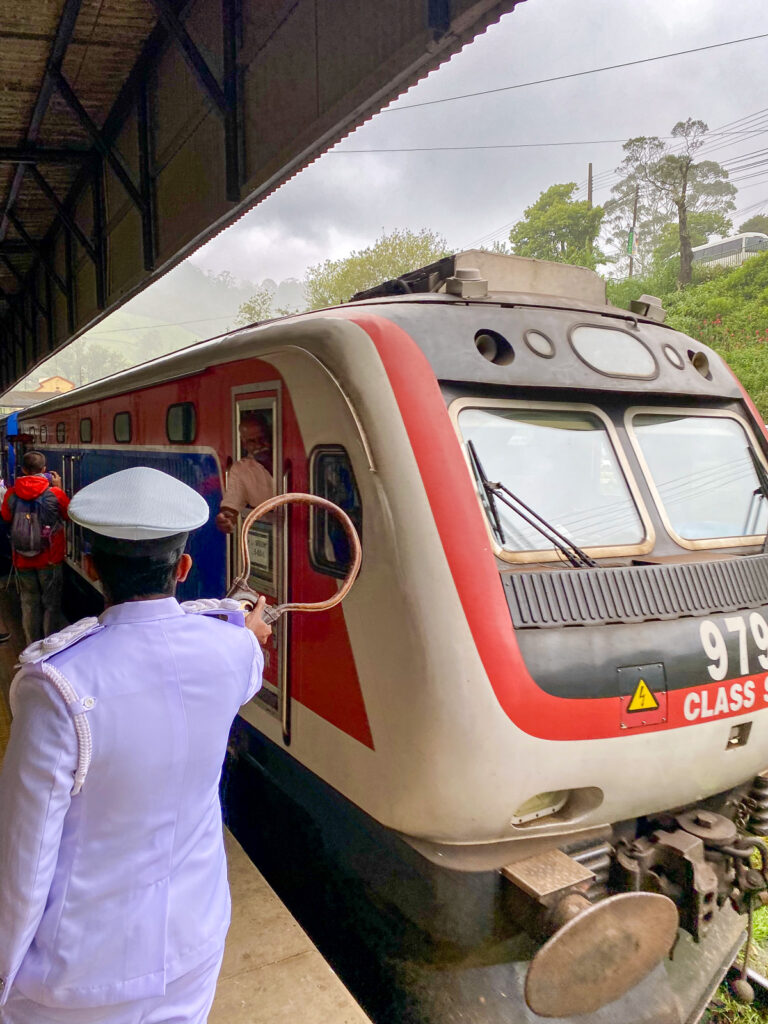
A conductor handing off the token pouch.
The tracks between Badulla and Kandy are all single lines, doubled at the stations to allow one train to stop while another passes in the opposite direction. To ensure that only one train at a time is on the rails between stations, there is an elaborate token system that has been in use since 1901. Each station has a box that is connected by telegraph to the boxes of other stations up and down the line. Each box has a drawer that locks, just large enough for a hockey puck-sized token. When a train is preparing to pass, the station master presses a switch on his box four times notifying the next station that a train is seeking permission for sole access to the track between them. The responding station must then place their token in the little drawer, shut it, and press four times in response, locking their token in place and unlocking the drawer at the requesting station. The requesting station places their token into a leather pouch with a large brass ring on it also covered in leather. This can then be handed off from the platform to a passing engineer, giving that train right of way to the next station, where they will have to exchange tokens for right of way to the next section of track. If a train doesn’t have a token, it must wait at the station for the train traveling in the other direction to pass. Apparently, the system falls under the category of “if it ain’t broke, don’t fix it,” since it has been in use for over a hundred and twenty years.
Not Everything Is What It Appears
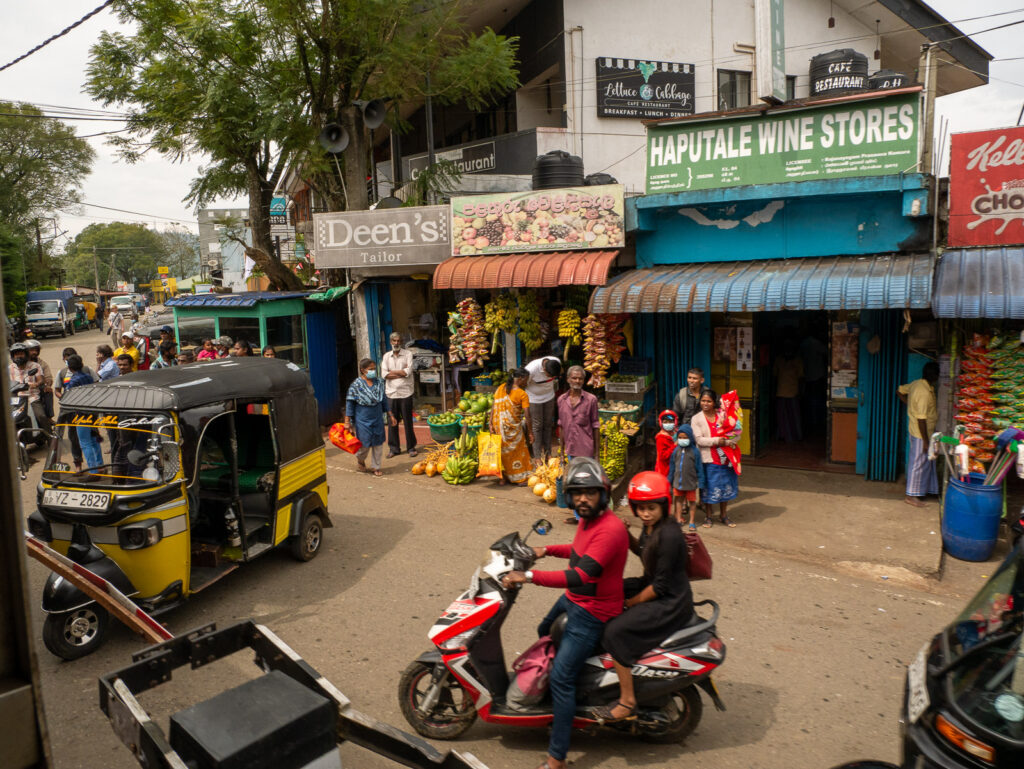
Mopeds, tuk-tuks, and the like wait at the crossing until we pass.
Waiting for the southbound train before we got our token gave us an opportunity to chat with some of the other passengers in our car. We finally noticed that while everyone looked Sri Lankan, accents abounded. There were also a couple NY Yankees—and an LA Dodgers—baseball caps, which we hadn’t seen anywhere else in our travels.
A man outside of the train was handing something up to a Sri Lankan-looking boy in the seat behind me.
“Is this your son?” I asked, leaning out the window.
“Yes,” he said.
I turned to the boy. “You know this guy?”
“He’s me dad,” he said. “Where are you from?” (The standard first question you are asked after meeting anyone in Sri Lanka.)
“The USA,” I said. “But you’re not from Sri Lanka, are you?”
“No.”
“Where are you from?”
“I’m Aw-stray-li-an,” he said.

A nice backdrop for a little cricket.
“I thought so,” I responded.
“How did you know?”
I pointed to my ear. “I can hear it.”
He nodded and smiled.
“You can hear where I’m from, right?”
He looked confused. “A little,” he said.
“You don’t live in Sri Lanka?” I double-checked.
“No.”
“You were born in Australia?”
“Yes.”
“Have you ever been to Sri Lanka before?”
“It’s me first time. I’ve come to see where me grandmum lives.”
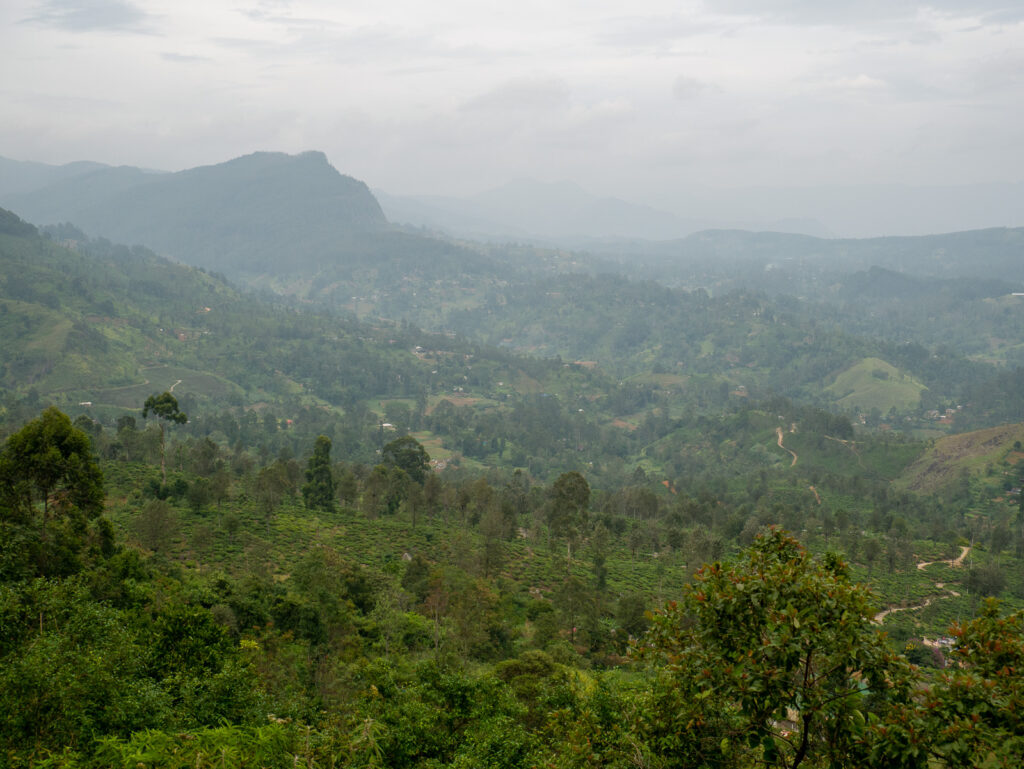
A whole world we never got to explore except from the train.
He looked about eleven or twelve.
“What do you think of Sri Lanka?” I asked.
“It’s different.”
“What do you mean?”
“There’s lots of jungle,” he said.
“And monkeys,” I added.
He smiled.
His dad still stood outside listening to our conversation. “Where in the US are you from?” he asked.
“Colorado,” I told him.
He nodded. “I have relatives in New York.”
I nodded. “You live in Australia now? You’re back visiting family?”
“Yes. My mother is still here.”
“Where does she live?”
He named some village I’d never heard of. “About an hour south of Colombo,” he added in response to the lack of recognition on my face.
I nodded again.
“What’s it like being back?”
“It’s beautiful,” he said, “and sad.”
I nodded one last time.
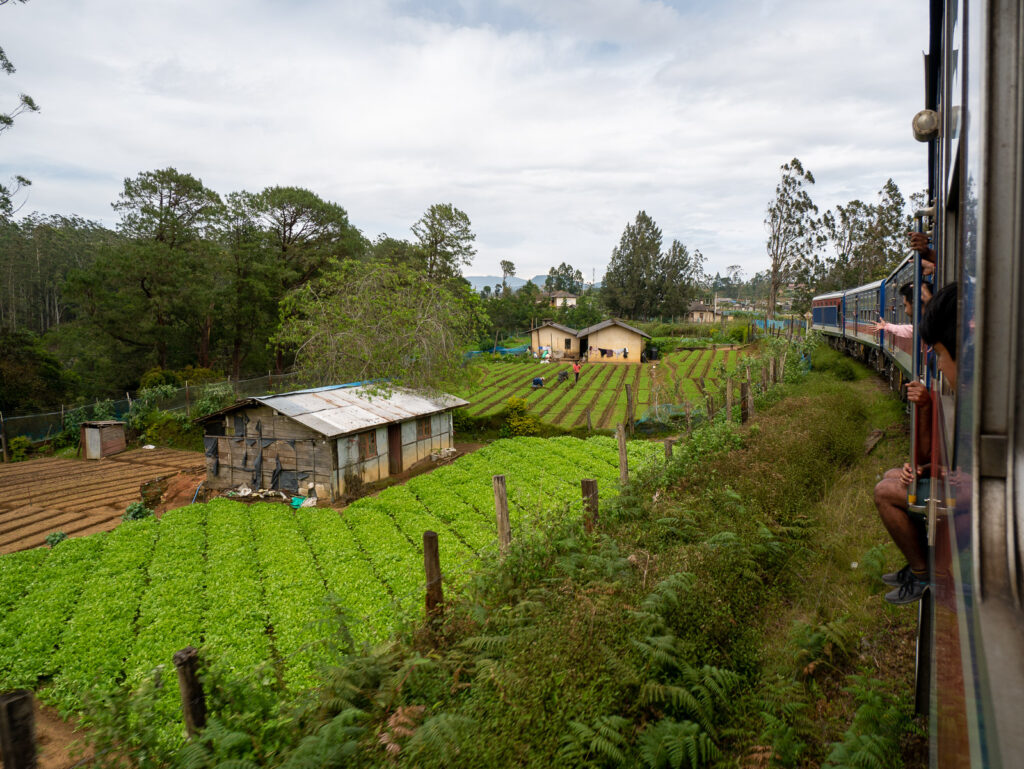
A highland garden for “English vegetables.” I wonder if Sri Lanka has its own version of Peter Rabbit?
It turned out we were on the train with members of the Sri Lankan diaspora that left during the civil war and were now returning to acquaint their children with where they had grown up. Most had settled in commonwealth nations—England, Canada, Australia, and the like. It was probably why they were on the tourist train and not a regular line. They were now foreign tourists visiting a land they had left for greener pastures, and one their children had never known.
The southbound train came through and our train whistle blew. The Australian boy’s father hurried to get back on the train. I smiled at his son and turned around to get ready for the next leg.
To the north of the station, a band of trees stands like sentinels on a rugged hillside as if watching over the way to the next section: the rugged nature preserve on the backside of Horton Plains National Park.
(To continue, go to Part 4: Into the Wilds)

Recent Comments